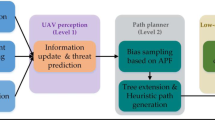Abstract
We propose a high-performance path planning algorithm for automatic target tracking in the applications of real-time simulation and visualization of large-scale terrain datasets, with a large number of moving objects (such as vehicles) tracking multiple moving targets. By using a modified Dijkstra’s algorithm, an optimal path between each vehicle-target pair over a weighted grid-presented terrain is computed and updated to eliminate the problem of local minima and losing of tracking. Then, a dynamic path re-planning strategy using multi-resolution representation of a dynamic updating region is proposed to achieve high-performance by trading-off precision for efficiency, while guaranteeing accuracy. Primary experimental results showed that our algorithm successfully achieved 10 to 96 frames per second interactive path-replanning rates during a terrain simulation scenario with 10 to 100 vehicles and multiple moving targets.
Similar content being viewed by others
References
Cohen-Or, D., Rich, E., Lerner, U., Shenkar, V., 1996. A real-time photo-realistic visual flythrough. IEEE Transactions on Visualization and Computer Graphics, 2(3):255–265. [doi:10.1109/2945.537308]
Dijkstra, E., 1959. A note on two problems in connexion the graphs. Numerische Mathematik, 1(1):269–271. [doi:10.1007/BF01386390]
Hoppe, H., 1998. Smooth View-Dependent Level-of-Detail Control and Its Application to Terrain Rendering. Proc. IEEE Visualization Conference, p.35–42.
Khatib, O., 1986. Real-time obstacle avoidance for manipulators and mobile robots. International Journal of Robotics Research, 5(1):90–98.
Latombe, J., 1991. Robot Motion Planning. Kluwer Academic Publishers, Boston, MA.
Latombe, J., 1999. Motion planning: a journey of robots, molecules, digital actors, and other artifacts. International Journal of Robotics Research, Special Issue on Robotics at the Millennium—Part I, 18(11):1119–1128.
Wan, M., Qu, H., Kaufman, A., 1999. Virtual Flythrough over Voxel-Based Terrain. Proc. IEEE Virtual Reality Conference, p.53–60.
Wan, M., Dachille, F., Kaufman, A., 2001. Distance-Field Based Skeletons for Virtual Navigation. Proc. IEEE Visualization Conference, p.239–245.
Xia, J., El-Sana, J., Varshney, A., 1997. Adaptive real-time level-of-detail-based rendering for polygonal models. IEEE Transactions on Visualization and Computer Graphics, 3(2):171–183. [doi:10.1109/2945.597799]
Author information
Authors and Affiliations
Additional information
Project partially supported by NSF (No. CCR0306438) and the Boeing Company, USA
Rights and permissions
About this article
Cite this article
Wan, M., Zhang, W., Murray, M.O. et al. Automatic target tracking on multi-resolution terrain. J. Zhejiang Univ. - Sci. A 7, 1275–1281 (2006). https://doi.org/10.1631/jzus.2006.A1275
Received:
Accepted:
Published:
Issue Date:
DOI: https://doi.org/10.1631/jzus.2006.A1275
Key words
- Target tracking
- Path planning
- Dijkstra’s algorithm
- Voxel-based modeling
- Multi-resolution terrain
- Real-time visualization and simulation




